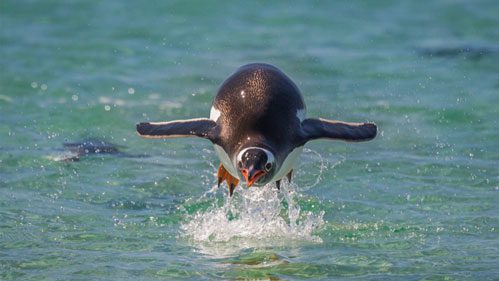Why can’t penguins fly?

Well, in a sense they really do fly, only through the water, not through the air. Penguins have strong wings and strong pectoral muscles to power them. Their bodies are streamlined as if for flight, so they still cut cleanly through the water. But water is much thicker than air, so their wings are shorter and stiffer than a normal bird’s wings. In fact, penguins are the only birds that are unable to fold their wings. Their wing bones are fused straight, making the wing rigid and powerful, like a flipper.
By the same token, penguins aren’t nearly as concerned about being light as birds that fly through the air. To dive deep, to catch fast-swimming prey, and to survive frigid temperatures, their bodies have huge fat supplies, heavy muscles, and densely packed feathers. There’s no way they could fly with such short wings and heavy bodies.
Penguins are an interesting example of specialization versus compromise. By giving up on flight they’ve been free to evolve bodies that perform superbly underwater. The similar-looking murres and guillemots of the Arctic can still fly, just not as well as some other birds; and they can also swim, though not as well as penguins.

All About Birds
is a free resource
Available for everyone,
funded by donors like you
American Kestrel by Blair Dudeck / Macaulay Library
